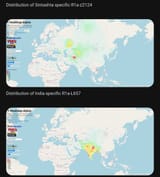Search Results
7/15/2025, 12:10:56 AM
>>17842325
>So it is likely that this Z93 did enter India around the same time from Russia, however, it would not be accompanied by any noticeable change in autosomal ancestry. Autosomal ancestry is that which recombines and is present in Chr 1-22 and is passed 50-50% from both parents to the child. Steppe autosomal ancestry only enters India post-1500 BCE
>The other option of course is that India was the source of R1a to Europe, to prove which we need tonnes of ancient DNA which we don't have. Europe also has ancient samples of ancestors of Z93, like Z645 and M417 and so on, which makes the European origin of R1a much more likely. So I will not consider this option yet, although it's plausible. There can always be haplogroups that reach multiple places due to some travel-savvy ancients :)
>This has happened before, we see y hg J2 and J1 (and subclades) from Iran, the Caucasus, and SC Asia neolithic in European samples in Karelia_EHG and Austria LBK, Hungary_Sopot without any apparent autosomal ancestry from the source regions. Autosomal ancestry from a parent can dilute to ~0% easily in 7 generations if the sons end up marrying local women (50%>25%>12.5%>6.25%>3.125%>1.5%>~0) ie 150 years
>Some make the argument that the lack of R1a in Shahr Sokhta, BMAC, Turan Eneolithic proves that R1a was absent in this region. To which my response is that these regions saw population turnover starting 4th mill BCE or even earlier by a population like Tepe Hissar/Seh Gabi to the tune of >60% and a resulting Y HG turnover. This is the reason why west Asian Y haplogroups like E1b and G2 appear in the record in the regions adjoining NW India. This turnover never happened in the Indian subcontinent as Indians lack this Anatolian heavy component. So I don't consider this evidence very strong, more data is needed
>So it is likely that this Z93 did enter India around the same time from Russia, however, it would not be accompanied by any noticeable change in autosomal ancestry. Autosomal ancestry is that which recombines and is present in Chr 1-22 and is passed 50-50% from both parents to the child. Steppe autosomal ancestry only enters India post-1500 BCE
>The other option of course is that India was the source of R1a to Europe, to prove which we need tonnes of ancient DNA which we don't have. Europe also has ancient samples of ancestors of Z93, like Z645 and M417 and so on, which makes the European origin of R1a much more likely. So I will not consider this option yet, although it's plausible. There can always be haplogroups that reach multiple places due to some travel-savvy ancients :)
>This has happened before, we see y hg J2 and J1 (and subclades) from Iran, the Caucasus, and SC Asia neolithic in European samples in Karelia_EHG and Austria LBK, Hungary_Sopot without any apparent autosomal ancestry from the source regions. Autosomal ancestry from a parent can dilute to ~0% easily in 7 generations if the sons end up marrying local women (50%>25%>12.5%>6.25%>3.125%>1.5%>~0) ie 150 years
>Some make the argument that the lack of R1a in Shahr Sokhta, BMAC, Turan Eneolithic proves that R1a was absent in this region. To which my response is that these regions saw population turnover starting 4th mill BCE or even earlier by a population like Tepe Hissar/Seh Gabi to the tune of >60% and a resulting Y HG turnover. This is the reason why west Asian Y haplogroups like E1b and G2 appear in the record in the regions adjoining NW India. This turnover never happened in the Indian subcontinent as Indians lack this Anatolian heavy component. So I don't consider this evidence very strong, more data is needed
Page 1
